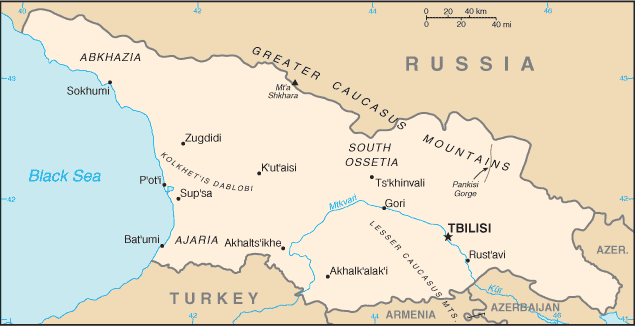Geography of Georgia
|
|
Location: Southwestern Asia, bordering the Black Sea, between Turkey and Russia
Geographic coordinates: Template:Coor dm
Map references: Commonwealth of Independent States
Area:
total:
69,700 km˛
land:
69,700 km˛
water:
0 km˛
Area - comparative: slightly smaller than South Carolina (US) or Benelux (EU)
Land boundaries:
total:
1,461 km
border countries:
Armenia 164 km, Azerbaijan 322 km, Russia 723 km, Turkey 252 km
Coastline: 310 km
Maritime claims: NA
Climate: warm and pleasant; Mediterranean-like subropical on Black Sea coast
Terrain: largely mountainous with Great Caucasus Mountains in the north and Lesser Caucasus Mountains in the south; Kolkhet'is Dablobi (Kolkhida Lowland) opens to the Black Sea in the west; Mtkvari River Basin in the east; Fertile soils in river valleys, flood plains, foothills of Kolkhida Lowland
Elevation extremes:
lowest point:
Black Sea 0 m
highest point:
Mt'a Mq'invartsveri (Gora Kazbeg) 5,048 m
Natural resources: forests, hydropower, manganese deposits, iron ore, copper, minor coal and oil deposits; coastal climate and soils allow for important tea and citrus growth
Land use:
arable land:
9%
permanent crops:
4%
permanent pastures:
25%
forests and woodland:
34%
other:
28% (1993 est.)
Irrigated land: 4,000 km˛ (1993 est.)
Natural hazards: earthquakes
Environment - current issues: air pollution, particularly in Rust'avi; heavy pollution of Mtkvari River and the Black Sea; inadequate supplies of potable water; soil pollution from toxic chemicals
Environment - international agreements:
party to:
Air Pollution, Biodiversity, Climate Change, Climate Change-Kyoto Protocol, Desertification, Endangered Species, Hazardous Wastes, Law of the Sea, Ozone Layer Protection, Ship Pollution, Wetlands
signed, but not ratified:
none of the selected agreements

